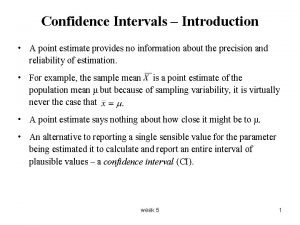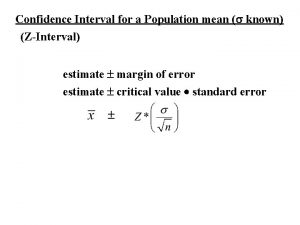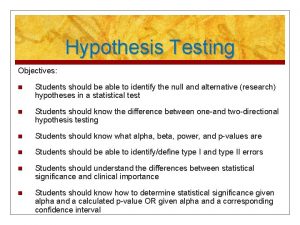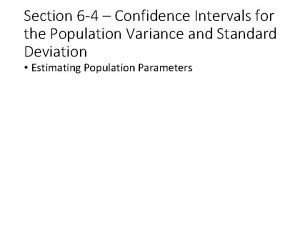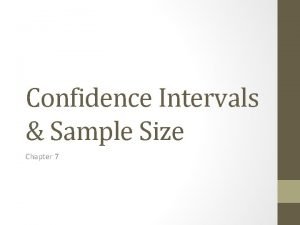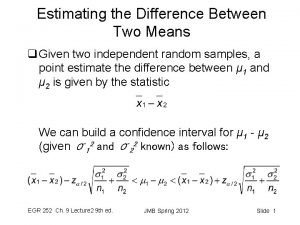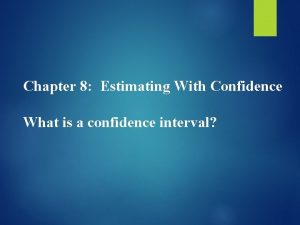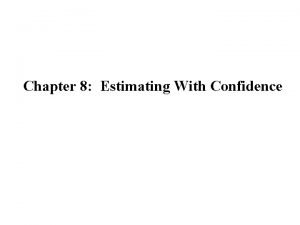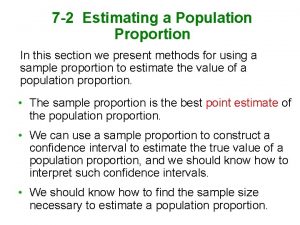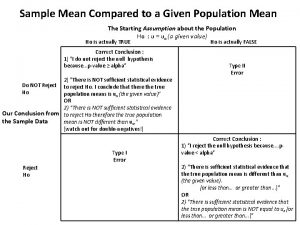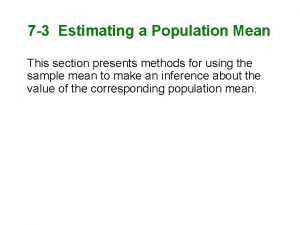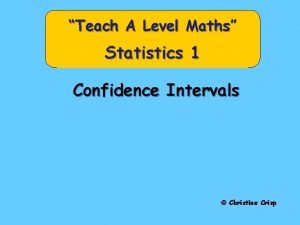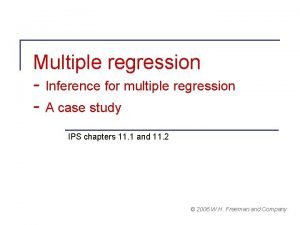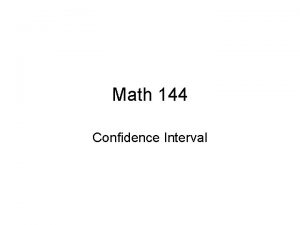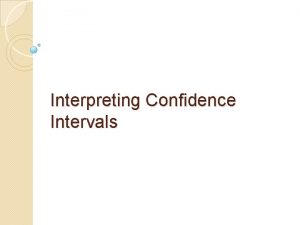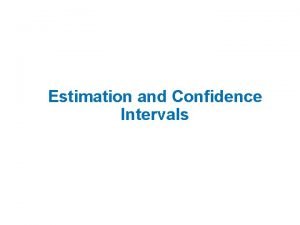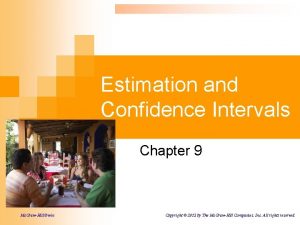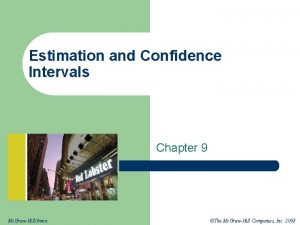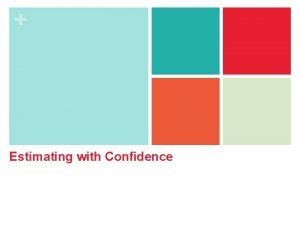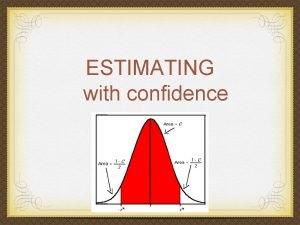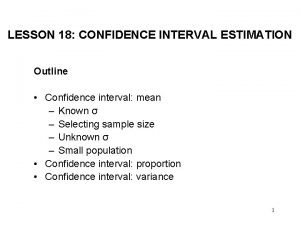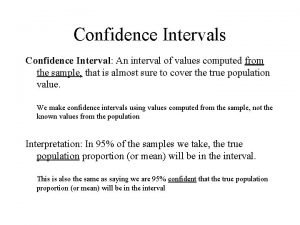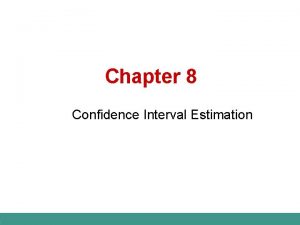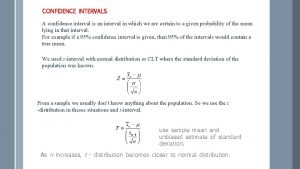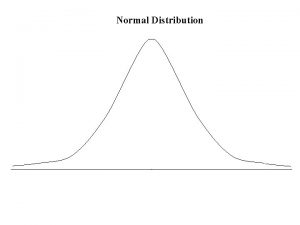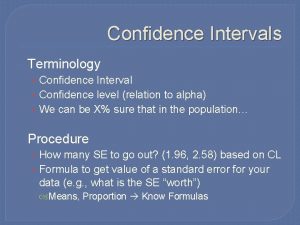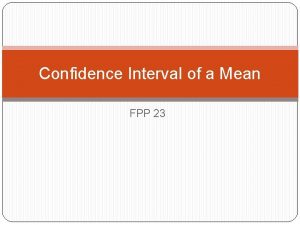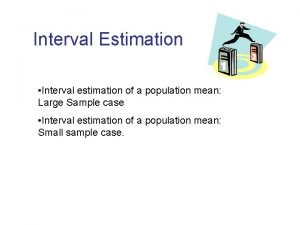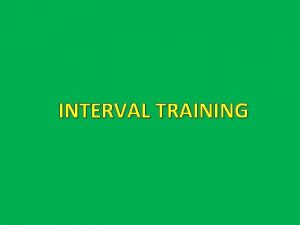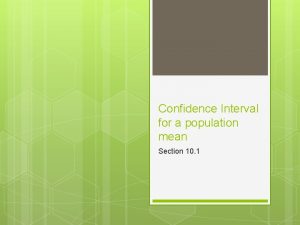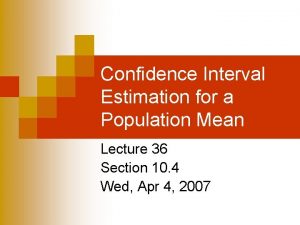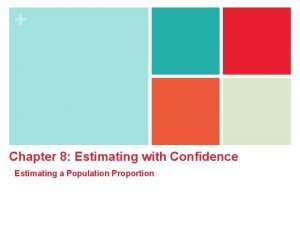Confidence Interval for a Population Mean l Estimating






















- Slides: 22

Confidence Interval for a Population Mean l. Estimating p l. Estimating m (s known) l. Estimating m (s unknown) l. Sample Size

Confidence Interval Terminology l l l Point Estimate: The “best” estimate for the population parameter using the sample data. Standard Error: The standard deviation of the sampling distribution Margin of Error: The maximum likely difference between the observed statistic and the population parameter. Confidence Level: The probability 1 -a that the confidence interval will contain the population mean. Critical Value: The value of z such that the area of the normal curve between –z and z is 1 -a.

Confidence Interval Definition A 1 -a Confidence Interval for the population parameter is an interval centered about the sample statistic with width equal to twice the margin of error. If many samples are taken from a population with the sample size then the proportion of the constructed confidence intervals that will contain the population parameter is 1 -a.

Confidence Interval Example A Gallup survey of 935 registered voters resulted in 312 answering “Yes” to “Do most members of Congress deserve reelection? ” Construct and interpret a 95% confidence interval for the population proportion of all registered voters who think that most members of Congress deserve reelection.

A Gallup survey of 935 registered voters resulted in 312 answering “Yes” to “Do most members of Congress deserve reelection? ” Construct and interpret a 95% confidence interval for the population proportion of all registered voters who think that most members of Congress deserve reelection. n = 935 np, nq > 5

A Gallup survey of 935 registered voters resulted in 312 answering “Yes” to “Do most members of Congress deserve reelection? ” Construct and interpret a 95% confidence interval for the population proportion of all registered voters who think that most members of Congress deserve reelection. n = 935 np, nq > 5 Margin of Error = ± 1. 96*0. 015 = 0. 03 0. 33 – 0. 03 = 0. 30 0. 33 + 0. 03 = 0. 36

A Gallup survey of 935 registered voters resulted in 312 answering “Yes” to “Do most members of Congress deserve reelection? ” Construct and interpret a 95% confidence interval for the population proportion of all registered voters who think that most members of Congress deserve reelection. n = 935 np, nq > 5 Margin of Error = ± 1. 96*0. 015 = 0. 03 0. 33 – 0. 03 = 0. 30 0. 33 + 0. 03 = 0. 36 Conclusion: We are 95% confident that between 30% and 36% of all registered voters in the US think that most members of Congress deserve reelection.

A Gallup survey of 935 registered voters resulted in 312 answering “Yes” to “Do most members of Congress deserve reelection? ” Construct and interpret a 95% confidence interval for the population proportion of all registered voters who think that most members of Congress deserve reelection. n = 935 Margin of Error = ± 1. 96*0. 015 = 0. 03 0. 33 – 0. 03 = 0. 30 0. 33 + 0. 03 = 0. 36 np, nq > 5 Conclusion: We are 95% confident that between 30% and 36% of all registered voters in the US think that most members of Congress deserve reelection. If we took many, many polls each with sample size 935 then each of these polls would result in different confidence intervals. 95% of all of these confidence intervals will contain the true population proportion for all registered voters.

Using the TI 83/84 1. 2. 3. 4. 5. 6. 7. 8. STAT TESTS 1 -Prop. ZInt (scroll down far) ENTER x = number of successes n = sample size C-Level = Confidence Level (1 -a) Calculate

Example A study was done to estimate the proportion of online college students who feel like they are enrolled in too many classes. Of the 150 students who were surveyed, 60 of them answered that they were. Determine a 95% confidence interval. STAT TESTS 1 -Prop. ZInt

Example A biologist wants to estimate the proportion of Tahoe Chickaree squirrels that survive the winter. The biologist tagged 450 randomly selected squirrels in the fall. By spring, only 320 of them were still alive. Determine and interpret the 90% confidence interval for the population proportion. STAT TESTS 1 -Prop. ZInt

Determining the Sample Size

Example You want to perform a study to estimate the proportion of college students who receive financial aid. You want to construct a 95% confidence interval with a margin of error no more that ± 6%. A. How many people should you survey if you have no idea in advance what the proportion is? B. Last year, the college found that 30% of all college students receive financial aid. How many people should you survey this year?

Estimating m (s known)

Effects on Confidence Intervals s: Decreasing s decreases the margin of error and the width of the confidence interval. n: Increasing n decreases the margin of error and the width of the confidence interval. 1 -a: Decreasing 1 -a (95% goes to 90% confidence) decreases the critical value and thus the margin of error and the width of the confidence interval.

Example Every year UC Davis measures the clarity of the lake. Based on historical data the standard deviation of clarity throughout the year is 1. 6 meters. Suppose that in 2010, the Davis researcher took 35 measurements and found the mean depth of clarity to be 21. 7 meters. Find a 95% confidence interval for the average depth of clarity of the lake. STAT TESTS ZInterval Stats

Example A restaurant owner wants to estimate the mean amount of money her customers spend at her restaurant. She knows that the standard deviation is $6. 42. She looks at 50 randomly selected receipts and calculates the mean of these receipts to be $43. 71. Determine and interpret the 90% confidence interval for the mean.

Example Among all Americans the standard deviation for amount of time spent watching TV per week was 4 hours. A study was done to estimate the mean number of viewing hours per week this year. The 45 randomly selected people surveyed averaged 18 hour per week. Determine and interpret the 95% confidence interval for the mean.

Confidence Intervals (s Unknown) Since the z-score formula involves the population standard deviation, we cannot use z for a confidence interval unless s is known. Instead, we use a distribution called the Student's t-Distribution. This distribution has an additional parameter, called the degrees of freedom, which is n-1. The rest of the confidence interval calculation is the same as before, but we use the sample standard deviation s as a point estimate for the population standard deviation. To use this you must either have an approximately normal distribution or a sample size larger than 30.

Example: CI for s Unknown A study was done to estimate the mean age when people buy their first new car. The mean age of purchase for the 32 randomly selected people was 22 and the standard deviation was 3. Determine and interpret the 95% confidence interval for the mean. STAT TESTS TInterval Stats

Example: CI for s Unknown A study was done to estimate the mean blood alcohol level for customers at the casino tables. The 25 randomly selected table players had a mean level of 0. 09 and the standard deviation was 0. 024. Determine and interpret the 95% confidence interval for the mean. Assume that the distribution of table player’s blood alcohol level is approximately normally distributed. STAT TESTS TInterval Stats

Determining the Sample Size Suppose that you want to conduct a study so that you can construct a 90% confidence interval for the mean number of physical therapy visitations a patient needs after receiving ACL surgery. You want the margin of error to be no more than 0. 5 visits. If you know the standard deviation is 4 visits, how many patients must participate in this study?
 Z table for 95 confidence interval
Z table for 95 confidence interval What is the point estimate of μ?
What is the point estimate of μ? Confidence interval for population mean
Confidence interval for population mean Confidence interval vs confidence level
Confidence interval vs confidence level Confidence interval vs confidence level
Confidence interval vs confidence level Confidence interval for population variance formula
Confidence interval for population variance formula How to find sample size
How to find sample size Confidence interval for mean
Confidence interval for mean Chapter 8 estimating with confidence
Chapter 8 estimating with confidence Chapter 8 estimating with confidence
Chapter 8 estimating with confidence Chapter 8 estimating with confidence
Chapter 8 estimating with confidence Estimating population proportion
Estimating population proportion Mean of population vs sample
Mean of population vs sample Population mean vs sample mean
Population mean vs sample mean What is z in confidence interval formula
What is z in confidence interval formula Confidence interval econometrics
Confidence interval econometrics Confidence interval multiple regression
Confidence interval multiple regression Confidence interval for variance
Confidence interval for variance 96 percent confidence interval
96 percent confidence interval 96 percent confidence interval
96 percent confidence interval What is the formula of confidence interval
What is the formula of confidence interval Confidence interval formula proportion
Confidence interval formula proportion Conditions for t interval
Conditions for t interval

